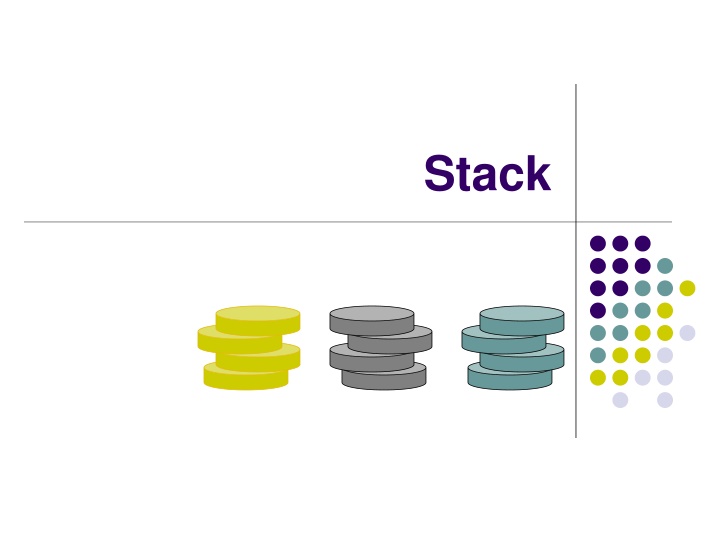
Abstract Data Types (ADTs) and Stack ADT
"Explore the concepts of Abstract Data Types (ADTs) and the Stack ADT, including their definitions, operations, and examples. Learn how to utilize built-in stack functionalities in Java and create a custom Stack interface. Dive into the world of data structures with practical applications." (319 characters)
Download Presentation

Please find below an Image/Link to download the presentation.
The content on the website is provided AS IS for your information and personal use only. It may not be sold, licensed, or shared on other websites without obtaining consent from the author. If you encounter any issues during the download, it is possible that the publisher has removed the file from their server.
You are allowed to download the files provided on this website for personal or commercial use, subject to the condition that they are used lawfully. All files are the property of their respective owners.
The content on the website is provided AS IS for your information and personal use only. It may not be sold, licensed, or shared on other websites without obtaining consent from the author.
E N D
Presentation Transcript
Abstract Data Types (ADTs) An abstract data type (ADT) is an abstraction of a data structure Example: ADT modeling a simple stock trading system The data stored are buy/sell orders An ADT specifies: Data stored The operations supported are order buy(stock, shares, price) order sell(stock, shares, price) void cancel(order) Operations on the data Error conditions associated with operations Error conditions: Buy/sell a nonexistent stock Cancel a nonexistent order
The Stack ADT The Stack ADT stores arbitrary objects Auxiliary stack operations: object top(): returns the last inserted element without removing it Insertions and deletions follow the last-in first-out scheme integer size(): returns the number of elements stored Think of a spring-loaded plate dispenser boolean isEmpty(): indicates whether no elements are stored Main stack operations: push(object): inserts an element object pop(): removes and returns the last inserted element
Stack: operations and their effects
ExampleI using built-in Stack: Reversing an Array Refer to ArrayReverseApp project The elements of an array can be reversed Using the Java built-in class called Stack Which is part of the java.util package Number is a base class for BigDecimal, BigInteger Byte, Double, Float, Integer, Long and Short
ExampleII using built-in Stack: Reversing an Array Refer to SecretMessageApp project The secret message is Encoded by having each individual word reversed And then decoded by means of an auxiliary stack Character are displayed in reverse order when Popped from the auxiliary stack variable
Our Stack Interface public interface Stack { Java interface corresponding to our Stack ADT Requires the definition of class StackException public int size(); public boolean isEmpty(); public Object top() throws StackException; Different from the built-in Java class java.util.Stack public void push(Object o) throws StackException; public Object pop() throws StackException; }
Exceptions Attempting the execution of an operation of ADT may sometimes cause an error condition, called an exception In the Stack ADT, operations pop and top cannot be performed if the stack is empty push cannot be performed if the stack is full Exceptions are said to be thrown by an operation that cannot be executed Attempting the execution of pop or top on an empty stack throws an StackException of push on a full stack throws an StackException
Array-based Stack Algorithmsize() returnt + 1 A simple way of implementing the Stack ADT uses an array Algorithmpop() ifisEmpty() then throw StackException else t t 1 returnS[t + 1] We add elements from left to right A variable keeps track of the index of the top element S t 0 1 2
Array-based Stack (cont.) The array storing the stack elements may become full Algorithmpush(o) ift = S.length 1 then throw StackException else t t + 1 S[t] o A push operation will then throw a StackException Limitation of the array-based implementation Not intrinsic to the Stack ADT S t 0 1 2
Example III using our Stack: Parentheses Matching ( , { , or [ must be paired with a matching ) , } , or [ correct: ( )(( )){([( )])} correct: ((( )(( )){([( )])} incorrect: )(( )){([( )])} incorrect: ({[ ])} incorrect: ( Refer to GroupingSymbolsAppproject
Parentheses Matching Algorithm Algorithm ParenMatch(X,n): Input: An array X of n tokens, each of which is either a grouping symbol, a variable, an arithmetic operator, or a number Output: true if and only if all the grouping symbols in X match Let S be an empty stack for i=0 to n-1 do if X[i] is an opening grouping symbol then S.push(X[i]) else if X[i] is a closing grouping symbol then if S.isEmpty() then return false {nothing to match with} if S.pop() does not match the type of X[i] then return false {wrong type} if S.isEmpty() then return true {every symbol matched} else return false {some symbols were never matched}
